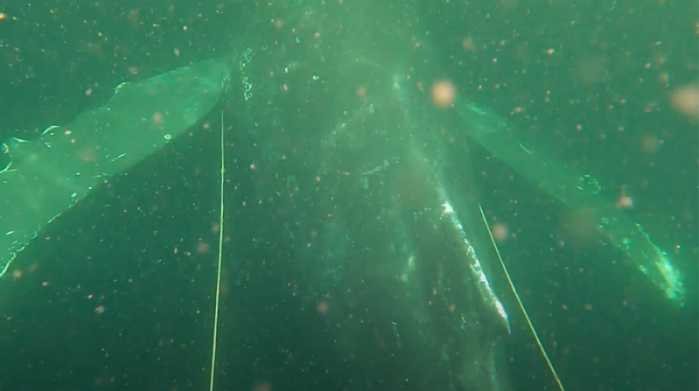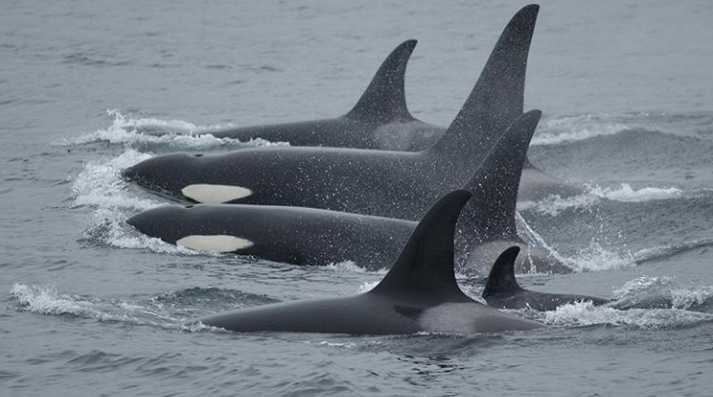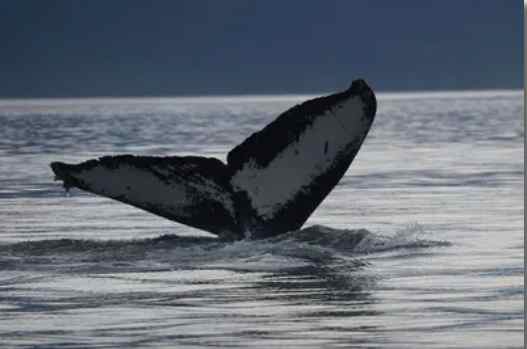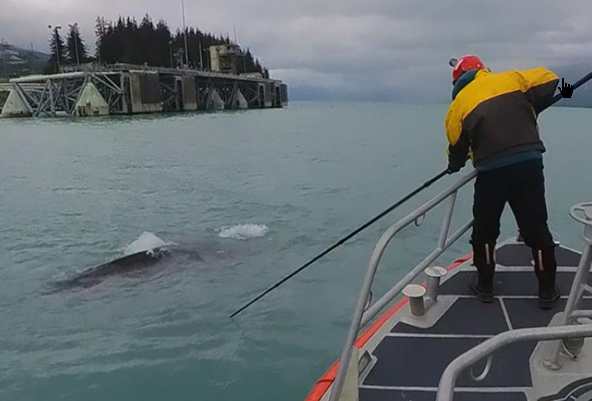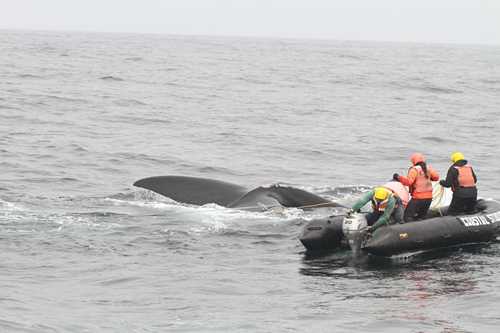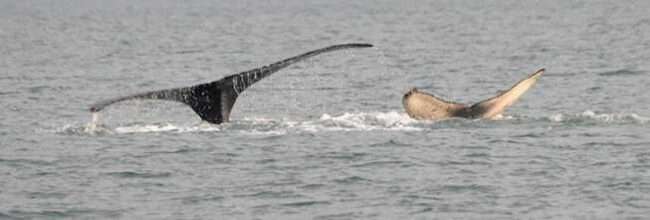
NOAA Fisheries whale experts were on the water near Juneau most of Monday, July 17, disentangling a well-known humpback whale calf from a crab pot line.
Biologist John Moran, Auke Bay Laboratories, discovered the entanglement while he was out on the water conducting research Monday morning. Marine mammal experts Suzie Teerlink and David Gann from the NOAA Fisheries Alaska Regional Office and Fred Sharpe with the Alaska Whale Foundation were shuttled out by a local whale-watching company to join Moran near Favorite Reef to further assist.
“This whale is this year’s calf of a well-known Juneau area humpback whale,” said Suzie Teerlink, Assistant Large Whale Entanglement Response Coordinator with NOAA Fisheries’ Alaska Regional Office in Juneau. “The mother is named Juneauite (SEAK # 1447). She earned her name from her persistent preference to feed near Juneau each summer. Calves are typically named following a theme on the mother’s name, and all of Juneauite’s calves follow local Juneau place names. This year’s calf, Herbert, is named after the Herbert Glacier and because it has white flukes. Unfortunately, this is not the first of Juneauite’s calves to become entangled. In 2016, Juneauite’s calf named Lincoln was also entangled in line and floats and was successfully disentangled by NOAA responders in nearly the same location.”

Herbert was entangled in recreational crab fishing gear (a crab ring); the foam floats could be seen trailing alongside the whale and the line was thought to be entangled on the pectoral fin and/or through the calf’s mouth. Coordinating with other marine mammal experts virtually, including Ed Lyman at the Hawaiian Islands Humpback Whale National Marine Sanctuary, the team patiently waited for the right opportunity to make a couple of strategic cuts to the gear using specialized cutting equipment designed to keep responders at a safe distance from the whale. They were able to remove much of the gear and were optimistic that the calf could shake loose any remaining section of the line.
A drone assessment of Herbert on Thursday, July 20, near Juneau confirmed that he was able to do just that. The team determined the humpback calf had no remaining entanglement.
The team plans to continue to monitor the calf throughout the summer. “If you see Juneauite and her calf, give them a little extra space after this traumatic experience, and if you happen to notice any unusual behavior, please call our hotline,” said Teerlink.
Manu Shakes Crab Pot Gear
This entanglement and response comes on the heels of two other recent humpback whale entanglements near Juneau earlier this month. One humpback whale was entangled in gillnet and has not been resighted. The other whale, known locally as “Manu,” was entangled in recreational crab pot gear in Fritz Cove, and a satellite tracking tag was attached to the entangling materials by authorized NOAA large whale entanglement responders.
While tagged, the animal moved on to remote areas and remained elusive. Authorized and experienced responders from the Petersburg Marine Mammal Center and Alaska Wildlife Foundation mounted efforts to successfully gain more information on the entanglement. On Friday, July 21, NOAA was able to confirm that Manu had finally shed the gear on his own.
“We saw a change in the satellite tag data that suggested it may be drifting and requested help recovering the gear and buoy,” said Teerlink. “Pybus Point Lodge asked their captains to look at the GPS locations we gave them, and they found the gear and sat tag floating.” Teerlink says all known gear is accounted for, and Manu is likely free from gear.
“Follow-up monitoring will hopefully reveal a healthy individual that is feeding normally,” said Fred Sharpe, advanced large whale entanglement responder with the Alaska Whale Foundation.
The sub-population of humpback whales that frequent the Juneau area is the focus of a thriving whale-watching industry and individual whales are well-known and loved by many in the community. This has been a tough month for humpback whales in the Juneau area. In addition to the entanglements, two other whales—including a different calf—were struck by vessels and sustained injuries.
“Between entanglements and vessel strikes, it seems like we have had more than normal unfortunate interactions with humpback whales near Juneau,” said Teerlink.
NOAA Fisheries reminds boaters to look for clues that whales may be in the area and to slow down when whales are around.
“With more whales, more boats, and more lines in the water, the chance for interactions will grow. These incidents are a good reminder to us all to be diligent mariners and fishers and do what we can to avoid interactions,” said Large Whale Entanglement Response Coordinator Sadie Wright, NOAA Fisheries’ Alaska Regional Office. “We are encouraging people to remove lines from the water when not in use, and to continue to submit your sightings of entangled whales to our hotline number.”
You can help reduce the entanglement threat. Please remove your gear from the water if it is not being actively fished. If possible, use a sinking line and avoid deploying excessive line or scope. These minor changes in practices and/or modification of gear can significantly mitigate the entanglement threat.
Be a First Responder
Herbert was fortunate that NOAA Fisheries discovered his entanglement, but this is typically not the case as an entangled whale is a large needle in a larger haystack—the ocean. We rely on the on-water community to find and report whales and other marine mammals in distress. NOAA Fisheries offers U.S. Whale Entanglement Response Level 1 – Alaska Region First Responder Training free online. The course takes about one hour to complete.
When well-intentioned members of the public take matters into their own hands to try and save a whale, they put themselves and the animals at risk. Only experienced responders who have been authorized by NOAA Fisheries and who have the appropriate training, experience, equipment, and support should attempt to disentangle or closely approach an entangled marine mammal.
The best way you can help an entangled marine mammal is to immediately report it by calling the NOAA Fisheries Alaska Marine Mammal Hotline at (877) 925-7773, or the U.S. Coast Guard on VHF Channel 16.
When reporting an entangled marine mammal, provide the following information:
- Date
- Location of the animal (including latitude and longitude, if known)
- A detailed description of the entangling gear or debris
- Where the entanglement is located on the animal
- The behavior and direction of the animal
- Condition of the animal (alive or dead)
- Species (if known)
Photos or videos from different angles and from a safe and legal distance (for humpbacks, greater than 100 yards) can provide valuable information to entanglement response teams. If possible, monitor the animal from at least 100 yards away until you receive additional guidance from NOAA or an authorized response team arrives.
[content id=”79272″]



